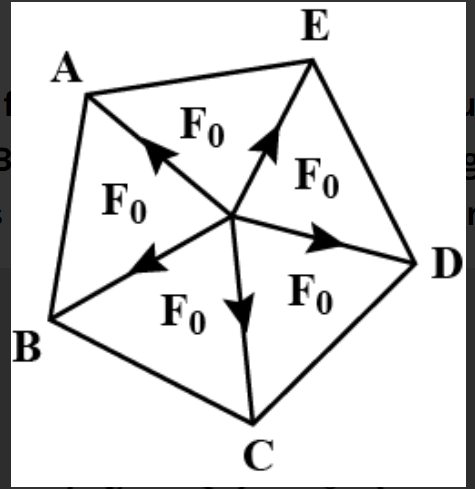
In the given figure, 0 is the centre of regular pentagon ABCDE. Five forces each of
magnitude $\mathrm{F}_{0}$ are acted as shown in figure. The resultant force is

(A) $5 F_{0}$
(B) $5 F_{0} \cos 72^{\circ}$
(C) $5 F_{0} \sin 72^{\circ}$
(D) zero
Answer
218.4k+ views
Hint: We know that the net force is the vector sum of all the forces acting on an object. When an object is in equilibrium (either at rest or moving with constant velocity), the net force acting on it is zero. A vector can only have zero magnitude if all of its components are zero. The action from a force can cause an object to move or speed up (accelerate), to slow down (decelerate), to stop, or to change direction. Since any change in velocity is considered acceleration, it can be said that a force on an object results in the acceleration of an object.
Complete step by step answer
When two or more forces act on an object, the resultant force can be found by adding up the individual forces. A resultant force is the single force and associated torque obtained by combining a system of forces and torques acting on a rigid body. The defining feature of a resultant force, or resultant force-torque, is that it has the same effect on the rigid body as the original system of forces.
According to Newton's First Law of motion, an object remains in the same state of motion unless a resultant force acts on it. If the resultant force on an object is zero, this means: a stationary object stays stationary. a moving object continues to move at the same velocity.
All forces are acting at an equal angle with each other and completing 360 degrees and are of the same magnitude so their resultant will be zero.
So, the correct answer is option D.
Note: We can conclude that the resultant is the vector sum of all the individual vectors. The resultant is the result of combining the individual vectors together. The resultant can be determined by adding the individual forces together using vector addition methods. Net force, also known as resultant force, is a vector quantity produced when two or more forces act upon one object. The concept of net force is the same as the mathematical concept of vector addition. When two forces acting on an object are equal in size but act in opposite directions, we say that they are balanced forces. A stationary object stays still. a moving object continues to move at the same speed and in the same direction.
Complete step by step answer
When two or more forces act on an object, the resultant force can be found by adding up the individual forces. A resultant force is the single force and associated torque obtained by combining a system of forces and torques acting on a rigid body. The defining feature of a resultant force, or resultant force-torque, is that it has the same effect on the rigid body as the original system of forces.
According to Newton's First Law of motion, an object remains in the same state of motion unless a resultant force acts on it. If the resultant force on an object is zero, this means: a stationary object stays stationary. a moving object continues to move at the same velocity.
All forces are acting at an equal angle with each other and completing 360 degrees and are of the same magnitude so their resultant will be zero.
So, the correct answer is option D.
Note: We can conclude that the resultant is the vector sum of all the individual vectors. The resultant is the result of combining the individual vectors together. The resultant can be determined by adding the individual forces together using vector addition methods. Net force, also known as resultant force, is a vector quantity produced when two or more forces act upon one object. The concept of net force is the same as the mathematical concept of vector addition. When two forces acting on an object are equal in size but act in opposite directions, we say that they are balanced forces. A stationary object stays still. a moving object continues to move at the same speed and in the same direction.
Recently Updated Pages
Two discs which are rotating about their respective class 11 physics JEE_Main

A ladder rests against a frictionless vertical wall class 11 physics JEE_Main

Two simple pendulums of lengths 1 m and 16 m respectively class 11 physics JEE_Main

The slopes of isothermal and adiabatic curves are related class 11 physics JEE_Main

A trolly falling freely on an inclined plane as shown class 11 physics JEE_Main

The masses M1 and M2M2 M1 are released from rest Using class 11 physics JEE_Main

Trending doubts
Understanding Collisions: Types and Examples for Students

Understanding Atomic Structure for Beginners

Understanding Centrifugal Force in Physics

Understanding Electromagnetic Waves and Their Importance

What Are Elastic Collisions in One Dimension?

Understanding Excess Pressure Inside a Liquid Drop

Other Pages
NCERT Solutions For Class 11 Physics Chapter 4 Laws Of Motion

NCERT Solutions for Class 11 Physics Chapter 3 Motion In A Plane 2025-26

NCERT Solutions For Class 11 Physics Chapter 12 Kinetic Theory - 2025-26

NCERT Solutions For Class 11 Physics Chapter 13 Oscillations - 2025-26

Motion In A Plane Class 11 Physics Chapter 3 CBSE Notes - 2025-26

Understanding Elastic Collisions in Two Dimensions




